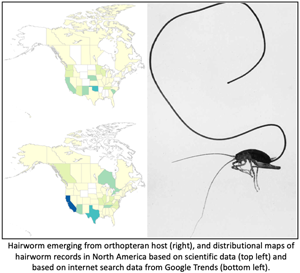Article contents
The people vs science: can passively crowdsourced internet data shed light on host–parasite interactions?
Published online by Cambridge University Press: 09 June 2021
Abstract

Every internet search query made out of curiosity by anyone who observed something in nature, as well as every photo uploaded to the internet, constitutes a data point of potential use to scientists. Researchers have now begun to exploit the vast online data accumulated through passive crowdsourcing for studies in ecology and epidemiology. Here, we demonstrate the usefulness of iParasitology, i.e. the use of internet data for tests of parasitological hypotheses, using hairworms (phylum Nematomorpha) as examples. These large worms are easily noticeable by people in general, and thus likely to generate interest on the internet. First, we show that internet search queries (collated with Google Trends) and photos uploaded to the internet (specifically, to the iNaturalist platform) point to parts of North America with many sightings of hairworms by the public, but few to no records in the scientific literature. Second, we demonstrate that internet searches predict seasonal peaks in hairworm abundance that accurately match scientific data. Finally, photos uploaded to the internet by non-scientists can provide reliable data on the host taxa that hairworms most frequently parasitize, and also identify hosts that appear to have been neglected by scientific studies. Our findings suggest that for any parasite group likely to be noticeable by non-scientists, information accumulating through internet search activity, photo uploads, social media or any other format available online, represents a valuable source of data that can complement traditional scientific data sources in parasitology.
- Type
- Research Article
- Information
- Copyright
- Copyright © The Author(s), 2021. Published by Cambridge University Press
Footnotes
These authors contributed equally to this article.
References
- 13
- Cited by




